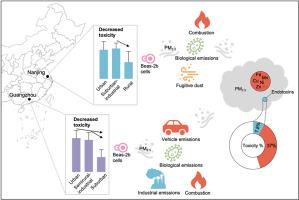Beyond Mass Concentration: The Critical Role of Chemical and Biological Compositions and Sources in PM2.5-induced Toxicity in Two Chinese Megacities
IF 7.3
2区 环境科学与生态学
Q1 ENVIRONMENTAL SCIENCES
引用次数: 0
Abstract
Studies have established evidence between the chemical composition of PM2.5 and its toxic effects, yet the toxicological contributions of biological components like endotoxins remain understudied. To address this gap, we developed an integrated assessment combining in vitro mixture-toxicity assays and source apportionment modeling. This approach quantifies the contributions of endotoxins, trace metals, and polycyclic aromatic hydrocarbons (PAHs) to PM2.5-induced intracellular oxidative stress and identifies source-specific toxicity patterns across six sites in Nanjing and Guangzhou, China. Our analysis revealed significant spatial gradients in PM2.5-induced toxicity correlated with anthropogenic activities. In Nanjing, suburban-industrial PM2.5 exhibited double the toxicity of rural samples, while urban and semi-rural industrial sites in Guangzhou showed double the toxicity of the suburban area. These patterns suggest that reduced exposure to anthropogenic emissions corresponds to lower PM2.5-induced toxicity, highlighting anthropogenic contributions as key toxic drivers. Although endotoxins, trace metals, and PAHs constituted approximately 2.23% of PM2.5 mass, they accounted for 35.9–56.9% of total reactive oxygen species (ROS) generation, with trace metals as the dominant contributor (31.6–46.7%), followed by endotoxins (4.24–12.2%) and PAHs (0.0218–0.135%). Source apportionment revealed dominant regional toxic drivers: fugitive dust (23.2–24.6%) and combustion (19.0–20.5%) in Nanjing; while vehicle (19.8%), industrial (18.4%), combustion (18.5%) and biological (20.0%) emissions in Guangzhou. Notably, biological emissions contributed 10.3–20.0% of total PM2.5-induced toxicity. These findings suggest that PM2.5-induced toxicity depends more on bioactive constituents than total mass concentration, emphasizing the need for toxicity-oriented air quality regulations, especially regarding bioaerosols, to supplement mass-based air quality standards.

质量浓度之外:中国两个特大城市中pm2.5毒性的化学和生物成分及其来源的关键作用
研究已经在PM2.5的化学成分及其毒性作用之间建立了证据,但内毒素等生物成分的毒理学贡献仍未得到充分研究。为了解决这一差距,我们开发了一种结合体外混合物毒性测定和来源分配模型的综合评估方法。该方法量化了内毒素、微量金属和多环芳烃(PAHs)对pm2.5诱导的细胞内氧化应激的贡献,并确定了中国南京和广州六个地点的源特异性毒性模式。我们的分析显示,pm2.5引起的毒性与人为活动相关,具有显著的空间梯度。在南京,郊区工业PM2.5的毒性是农村样本的两倍,而广州的城市和半农村工业场所的毒性是郊区样本的两倍。这些模式表明,减少暴露于人为排放对应于pm2.5诱发的毒性降低,突出表明人为因素是主要的毒性驱动因素。虽然内毒素、微量金属和多环芳烃约占PM2.5质量的2.23%,但它们占总活性氧(ROS)生成的35.9-56.9%,其中微量金属占主导地位(31.6-46.7%),其次是内毒素(4.24-12.2%)和多环芳烃(0.0218-0.135%)。源解析结果表明,南京主要区域毒性驱动因子为扬尘(23.2 ~ 24.6%)和燃烧(19.0 ~ 20.5%);其次是机动车(19.8%)、工业(18.4%)、燃烧(18.5%)和生物(20.0%)。值得注意的是,生物排放占pm2.5引起的总毒性的10.3-20.0%。这些发现表明,pm2.5引起的毒性更多地取决于生物活性成分,而不是总质量浓度,强调需要制定以毒性为导向的空气质量法规,特别是关于生物气溶胶的法规,以补充基于质量的空气质量标准。
本文章由计算机程序翻译,如有差异,请以英文原文为准。
求助全文
约1分钟内获得全文
求助全文
来源期刊

Environmental Pollution
环境科学-环境科学
CiteScore
16.00
自引率
6.70%
发文量
2082
审稿时长
2.9 months
期刊介绍:
Environmental Pollution is an international peer-reviewed journal that publishes high-quality research papers and review articles covering all aspects of environmental pollution and its impacts on ecosystems and human health.
Subject areas include, but are not limited to:
• Sources and occurrences of pollutants that are clearly defined and measured in environmental compartments, food and food-related items, and human bodies;
• Interlinks between contaminant exposure and biological, ecological, and human health effects, including those of climate change;
• Contaminants of emerging concerns (including but not limited to antibiotic resistant microorganisms or genes, microplastics/nanoplastics, electronic wastes, light, and noise) and/or their biological, ecological, or human health effects;
• Laboratory and field studies on the remediation/mitigation of environmental pollution via new techniques and with clear links to biological, ecological, or human health effects;
• Modeling of pollution processes, patterns, or trends that is of clear environmental and/or human health interest;
• New techniques that measure and examine environmental occurrences, transport, behavior, and effects of pollutants within the environment or the laboratory, provided that they can be clearly used to address problems within regional or global environmental compartments.
 求助内容:
求助内容: 应助结果提醒方式:
应助结果提醒方式:


